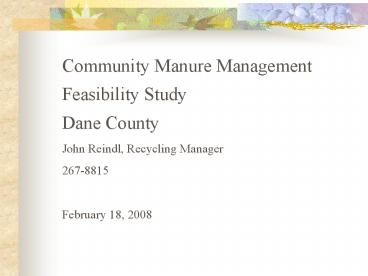Community Manure Management - PowerPoint PPT Presentation
1 / 26
Title:
Community Manure Management
Description:
Approximately 400 dairy farms with 50,000 milking cows (125,000 cattle) declining slowly ... a cow produces ca.120 pounds of manure a day - only 10 farms ... – PowerPoint PPT presentation
Number of Views:31
Avg rating:3.0/5.0
Title: Community Manure Management
1
Community Manure Management Feasibility
Study Dane County John Reindl, Recycling
Manager 267-8815 February 18, 2008
2
Dane County Livestock Background Approximately
400 dairy farms with 50,000 milking cows (125,000
cattle) declining slowly - a cow produces
ca.120 pounds of manure a day - only 10 farms
with more than 500 cows - 3 with 1,000 or
more - concentrated in the Lake Mendota
Watershed Approximately 80 farms with 20,000
hogs declining rapidly
3
(No Transcript)
4
History of this Effort For many years, the
County has worked with farmers to improve their
management of manure Fish killed due to manure
runoffs Manure management task force established
spreading standards Dane County Board adopted a
resolution for a feasibility study of a community
system
5
What We Have Done Feasibility study advisory
committee appointed in Spring 2006 In the spring
of 2007, the County hired a firm to do a
feasibility study for the management of livestock
manure, covering two test areas. Study looked at
systems both at the community and the individual
farm level.
6
Study Goals The County has multiple goals that
it wants met in the management of manure as well
as numerous issues that need to be considered
when meeting the goals.
7
The main goal is to both strengthen the livestock
industry in Dane County, while protecting water
quality, as related to manure management,
including the N, P and K nutrient management
requirements for land application. Reduction of
phosphorus to our water bodies is essential.
8
- Technologies Studied
- The County identified 23 categories of possible
technologies, and selected four that, at a
minimum, are to be included in the report - Advanced solids separation and recovery (two
levels) - Phosphorus removal and recovery
- Anaerobic digestion with methane recovery
- Combustion could include pyrolysis or
gasification
9
Information Developed by Study Survey of farms
and current practices and interest Technology
description and review Additional materials that
could be handled by the system Transportation
requirements (truck or pipeline) Recovered
products Solids bedding, compost, fertilizer,
fiberboard, composite
plastics, horticultural
containers, other Liquids irrigation, flush or
wash down water Energy methane for
electricity, fuel
10
Information being Developed (contd) Economics -
Current manure costs of farms - For the systems
under study (w/sensitivities) - Estimates of
future challenges and costs Potential financial
assistance Non-monetary impacts Alternative
business structures - there is no pre-conceived
ownership or business structure
11
Example Schematic
12
Project Status Final drafts done Advisory
committee agendas, minutes, background papers and
draft chapters are on the Internet
13
Some Results Can remove 45-85 of the P with
advanced solids separation, with or without AD
combustion can remove nearly 100 P. This is
equal to 273,000 to 320,000 pounds of phosphorus
per year from our two example clusters. Pipelines
reduce costs of transportation considerably in
dense clusters Capital costs are 1,000 - 4,000
per A. U. -- joint systems can reduce costs by as
much as 50 per A. U.
14
Some Results (contd) Revenues can exceed OM
costs in some situations For the AD system with
advanced solids separation (85 P removal), there
are three net revenues streams - Over 60
is from the sale of solids - Next largest
(30) are the renewable energy credits
and GHG emission credits. GHG credits are
two thirds of this revenue - Lowest (11) is
the net value of the electricity.
15
GHG Impacts of Alternative Manure Management
Systems
Source Kwantitatieve analyse van de
milieubelasting van drie organische mestketens en
kunstmest, September 2006
16
N2O Emissions from Alternative Manure Management
17
NOx Emissions of Alternative Manure Management
18
Fine Particles Emissions of Alternative Manure
Management
19
Ammonia Emissions from Alternative Manure
Management
20
Some Results (contd) Depending on capital
recovery factors (time frame, interest rate), the
cost of several community systems is less than
current costs for manure management, plus
producing a higher level of environmental
protection
21
Next Steps Advisory committee, County Executive,
consultant and farmers met to discuss the report
and possible next steps Report will be widely
publicized for use by anyone County Budget for
2008 includes funding for working with farmers to
move forward
22
Prospects for Success There is a high level of
interest in this issue as shown by the response
to this summers demonstration of a sand and
solids separation system at the Ripp Diary Farm
and by the number of contacts to our web page
when we announce significant steps of progress As
an optimist, I see the West Flanders area of
northern Belgium as an example of what can be
accomplished
23
Comparative Data Dane Co. West
Flanders Area 3,084 km2 3151
km2 Cattle 125,000 415,000 Swine 20,000
3,140,000 Population 460,000
1,130,000 Manure treatment 1 gt 70
systems
24
Manure Management Systems in West Flanders
25
Prospects for Success (contd) As a realist, I
also understand that not only is Dane County
different than West Flanders, but that it will
take time, effort, new technologies, and
ultimately, money, to achieve changes. I believe
that the study that is being finished for Dane
County is just one step in a long process and
that future solutions could be dramatically
different from what we see today.
26
For More Information www.danewaters.com select
Management Issues and Activities or contact
John Reindl 267-8815































